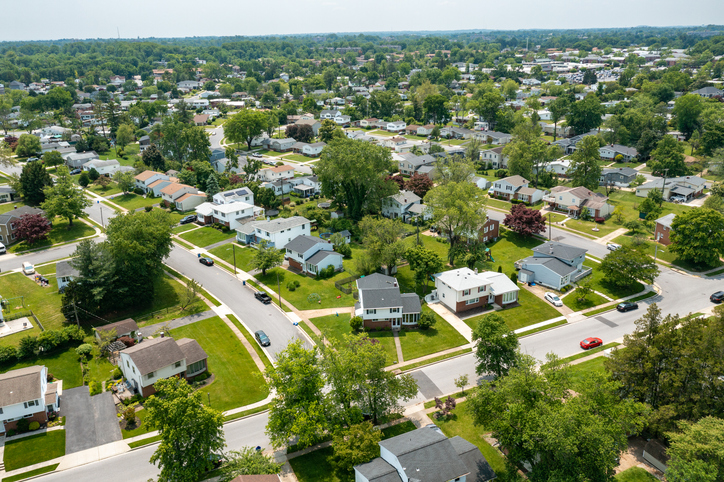
The housing stock statewide has grown and vacancy rates have decreased slightly, but homes in Pennsylvania are among the oldest in the country and continue to age, according to the Pennsylvania Housing Finance Agency’s 2023 Pennsylvania Comprehensive Housing Study.
Occupied vs. Vacant
As of 2022, the commonwealth had more than 5.8 million housing units, which was a 4% increase since 2010. Of those, approximately 5.3 million units were occupied at the time of the study, with 69% occupied by homeowners and 31% occupied by renter households.
The remaining 521,126 units were vacant. Vacancy levels have remained similar in the past decade, between 11-12% and decreasing to 9% in 2022.
Pennsylvania’s housing stock, especially rental housing, remains concentrated in the most populated areas of the state, including Philadelphia, southeast counties and Pittsburgh.
The five counties with the most housing units as of 2022 were:
- Philadelphia: 730,630 occupied units, 71,501 vacant units
- Allegheny: 602,734 occupied, 57,097 vacant
- Montgomery: 346,692 occupied, 17,012 vacant
- Bucks: 255,599 occupied, 8,765 vacant
- Delaware: 229,039 occupied, 13,206 vacant
Forest County, Sullivan County and Potter County had the highest vacancy rates in the state, while Philadelphia and Pittsburgh had the largest number of vacant units. Notably, the majority of the vacant housing stock was off the market in some form, whether temporarily or indefinitely.
Unit Size
While data on the size of housing units in Pennsylvania is limited, the 2021 American Housing Survey found that approximately:
- 19% of units were smaller than 1,000 square feet
- 26% were 1,000-1,500 square feet
- 19% were 1,500-2,000 square feet
- 37% were larger than 2,000 square feet
Other key findings concerning unit size included:
- 67% of owner-occupied units had either two or three bedrooms
- 2% of owner-occupied units had only one bedroom
- 31% of owner-occupied units had four or five bedrooms
- 6% of renter-occupied units had no bedrooms
- 28% of renter-occupied units had one bedroom
- 58% of renter-occupied units had two or three bedrooms
Building Types
Single-family detached homes continued to be the predominant type of housing across Pennsylvania, with 3.3 million such homes as of 2022, making up 57% of all units. The rest of the housing stock was made up of:
- Attached single-family homes: 19%
- Units in large apartment buildings of 10 or more units: 10%
- Units in duplexes: 4%
- Mobile homes: 4%
- Units in small apartment buildings of five to nine units: 3%
Notably, mobile homes made up the largest shares of the housing stock in Green, Tioga and Forest Counties (16-18% in each) and were more common in rural counties in the north and west.
Building Age
Old homes in Pennsylvania continue to age. The median age of housing in the commonwealth is 57 years old, making housing in Pennsylvania some of the oldest in the country, only behind New York (63), Massachusetts (58) and Rhode Island (61).
As of 2022, a quarter of occupied housing units were built before 1940. This number has decreased since 2010. Philadelphia and Schuylkill Counties are home to the oldest housing, with median construction years of 1949 and 1944 respectively. The statewide median year of construction is 1964, and Pike, Monroe and Chester Counties have the newest housing stocks, with the median years built in the 1980s for each county.
Building Quality
With such old housing stock, limited data indicated that the quality of some Pennsylvania housing may be inadequate. As of 2021, 69,100 units were found to be “severely inadequate,” meaning they lacked hot or cold water or a full bathroom, lacked functioning heating equipment, lacked electricity, had exposed wiring or had at least five maintenance problems such as water leaks, holes in the floor or a rat infestation.
Another 234,700 units were “moderately inadequate,” meaning they had three or four maintenance problems or lacked a kitchen sink, working refrigerator, cooking equipment or consistently functioning toilets.
To learn more details about Pennsylvania’s housing stock, read the PHFA’s full 2023 report.
Topics
Member Discussion
Recent Articles
-
Are Colorful Toilets Making a Comeback? Realtors® React
- April 24, 2025
- 2 min. read
“Color in a bathroom is always a joy during the initial design, but it’s crucial to remember that not all fixtures age uniformly,” reminds PAR President Bill Lublin.
-
Three Pa. Cities Make Top 100 Safest From Natural Disasters
- April 23, 2025
- 2 min. read
Pittsburgh was named the eighth safest city from natural disasters in a study of 477 of the biggest U.S. cities, completed by Home Gnome. Two other cities made the top 100.
-
Pennsylvania Home Sales Rose 21% in March
- April 22, 2025
- 2 min. read
Home sales grew 21% in March compared to the previous month in Pennsylvania, according to a report prepared for PAR. March home sales totaled 8,230, up from 6,751 in February.
Daily Emails
You’ll be the first to know about real estate trends and various legal happenings. Stay up-to-date by subscribing to JustListed.



